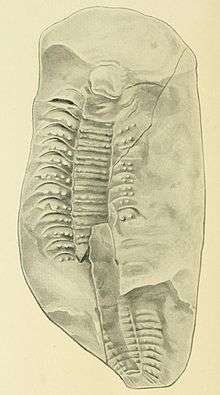Arthropleuridea
Arthropleuridea is an extinct subclass of myriapod arthropods that flourished during the Carboniferous period, having first arose during the Silurian, and perishing due to climate change just before the Early Permian. Members are characterized by possessing diplosegement (fused "double segments", as in modern-day millipedes) paranotal tergal lobes separated from the body axis by a suture, and by sclerotized plates buttressing the leg insertions. Despite their unique features, recent phylogenetic research suggests Arthropleuridea be included among millipedes in the class Diplopoda.[1][2] The subclass contains three recognized orders, each with a single genus.[3]
| Arthropleuridea | |
|---|---|
 | |
| Arthropleura fossil illustration | |
| Scientific classification | |
| Kingdom: | Animalia |
| Phylum: | Arthropoda |
| Class: | Diplopoda |
| Subclass: | †Arthropleuridea Waterlot, 1934 |
| Orders | |
Paleobiology
Arthropleurids lived in the moist coal swamps that were common at the time and may have burrowed in the undergrowth. They were either herbivores or detritivores. Besides their size, their most distinguishing features were their legs with eight segments (as many as 30 pairs) and extremely tough exoskeletons. There is no evidence of spiracles, so the animals must have used lungs or gills for respiration.[2]
Most arthropleurideans are thought to have been terrestrial, although, without any known respiratory structure, terrestriality is assumed only by analogy to modern arthropods.[4] Early forms, however, including Eoarthropleura (order Eoarthropleurida), appear to have been aquatic. For this reason, some question Arthropleuridea's inclusion among millipedes because no modern aquatic myriapods are known.[2]
Distribution and size
Arthropleuridea is most famous for Arthropleura (order Arthropleurida). Tracks from Arthropleura up to 50 cm wide have been found at Joggins, Nova Scotia.[5] Reaching over 2 meters in length, arthropleurids are among the largest arthropods ever to have lived. The lack of large terrestrial vertebrate predators and the highly oxygenic atmosphere at that time probably enabled them to grow so large.[6] Arthropleura became extinct as the climate became drier and the coal swamps dried out.[2] Arthropleura has been found from the Upper Carboniferous of Europe and North America.
Eoarthropleura has been found from the Upper Silurian through the Upper Devonian of Europe and North America.[7]
Microdecemplex, of the order Microdecemplicida, was smaller in comparison to the other arthropleurideans, at just a few millimeters long. The genus is known from the Middle through Upper Devonian of New York state, USA.[3]
Classification and placement
After several decades of uncertainty, Arthropleuridea was placed within the Diplopoda in the year 2000.[8] However, there is still controversy regarding the relationships of the three orders to living millipede groups.[1][9] Some authors place Arthropleuridea within the Chilognatha, as a sister group to all living Chilognathan millipedes (Pentazonia + Helminthomorpha).[8][10] An alternate hypothesis breaks up the subclass: placing the orders Arthropleurida and Eoarthropleurida within the basal Penicillata (as sister to the living Polyxenida), and leaving only Microdecemplicida as a sister group to the living Chilognatha.[11] Under this hypothesis, Arthropleuridea would be paraphyletic.
See also
- Archipolypoda, another extinct group of millipedes including the earliest known air-breathing animal
- Euthycarcinoidea, a group of enigmatic arthropods that may be ancestral to myriapods
- Colonization of land, major evolutionary stages leading to terrestrial organisms
References
- Shear, William A.; Edgecombe, Gregory D. (2010). "The geological record and phylogeny of the Myriapoda". Arthropod Structure & Development. 39 (2–3): 174–190. doi:10.1016/j.asd.2009.11.002. PMID 19944188.
- Kazlev, M. Alan. "Class? and Order Arthropleurida". Palaeos. Archived from the original on 13 March 2006. Retrieved 2006-04-12.
- Shultz, Jeff; Heather Wilson. "Arthropleuridea". Studies in Arthropod Morphology and Evolution. University of Maryland. Archived from the original on 2007-04-03. Retrieved 2006-04-12.
- Fortey, Richard; R. H. Thomas (1998). Arthropod Relationships. Springer. ISBN 0-412-75420-7.
- "The Excitement of Discovery". Virtual Museum of Canada. Archived from the original on February 4, 2012. Retrieved 2006-04-17.
- M. G. Lockley & Christian Meyer (2013). "The tradition of tracking dinosaurs in Europe". Dinosaur Tracks and Other Fossil Footprints of Europe. Columbia University Press. pp. 25–52. ISBN 9780231504607.
- William Shear & Paul Selden (1995). "Eoarthropleura (Arthropoda, Arthropleurida) from the Silurian of Britain and the Devonian of North America" (PDF). Neues Jahrbuch für Geologie und Paläontologie, Abhandlungen. 196 (3): 347–375.
- Wilson, Heather M.; Shear, William A. (2000). "Microdecemplicida, a new order of minute arthropleurideans (Arthropoda: Myriapoda) from the Devonian of New York State, U.S.A.". Transactions of the Royal Society of Edinburgh: Earth Sciences. 90 (04): 351–375. doi:10.1017/S0263593300002674.
- Sierwald, Petra; Bond, Jason E. (2007). "Current Status of the Myriapod Class Diplopoda (Millipedes): Taxonomic Diversity and Phylogeny". Annual Review of Entomology. 52 (1): 401–420. doi:10.1146/annurev.ento.52.111805.090210. PMID 17163800.
- Hoffman, RL (1969). "Myriapoda, exclusive of Insecta". In RC Moore (ed.). Treatise on Invertebrate Paleontology, Pt. R, Arthropoda 4. Lawrence: Geol. Soc. Am./Univ. Kans. Press. pp. R572–606.
- Kraus, O; C. Brauckman (2003). "Fossil giants and surviving dwarfs. Arthropleurida and Pselaphognatha (Ateolocerata, Diplopoda): characters, phylogenetic relationships and construction". Verh. Naturwiss. Ver. Hamburg. 40 (5): 5–50.